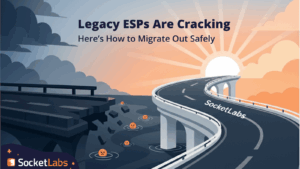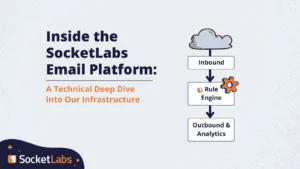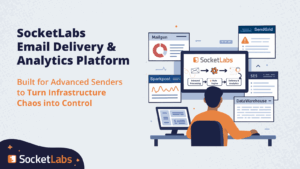https://socketlabs-1.wistia.com/medias/lqhg9bjkdm?embedType=async&videoFoam=true&videoWidth=1280
Total Runtime: 15:00
1:08 – What inspired you to start SocketLabs 14 years ago?
2:33 – What’s an MTA and why is it important in email?
4:41 – Who benefits from using an MTA? How is SocketLabs Hurricane MTA different? Why SocketLabs?
6:02 – What makes our Hurricane MTA so flexible?
8:24 – How is SocketLabs changing the landscape of email infrastructure with its technology?
10:19 – What’s on the technology and innovation roadmap at SocketLabs?
12:56 – How is SocketLabs customizing infrastructure for more complex senders?
(Keep scrolling for a full transcript of the conversation.)
Intro
Email as a marketing tool, communication tool, or transactional tool, has largely gone unchanged since its creation. Now as the world of technology and SaaS evolve at lightening speed, SocketLabs CTO, Bill Volz sees new opportunity in evolving email and making a smarter, simpler, more efficient email solution for business.
The Conversation
Lauren:
Hi everybody. My name is Lauren Meyer, EVP of Product Marketing & Brand Strategy for SocketLabs. Today, I’m super excited to be sitting down for a conversation with one of our co-founders and our current CTO, Bill Volz. Not only has this guy been with SocketLabs since the very beginning, creating the company about 14 years ago in a suburb right outside of Philadelphia, Pennsylvania, but he’s been developing and building great technology since the nineties. And honestly, Bill, I’m not trying to make you sound old, but you’ve been doing this stuff for a quarter of a decade! So now I really understand why our infrastructure is so incredibly awesome.
So, today Bill and I will be going deep into our email delivery infrastructure, the future of SocketLabs, and our technical roadmap. And hopefully, we’ll also get into all kinds of other nerdy things about email that I think you guys are gonna really love. So thanks so much for joining me today, Bill, what do you think? Should we kick this off?
Bill:
Yep. I’m all ready! Always excited to talk about email and technology!
Question 1: What inspired you to start SocketLabs 14 years ago?
Bill:
So we didn’t really come out to build a product and decide to sell it. The product kind of evolved based on customer feedback and demand. We were building component libraries targeted at developers to help them receive and send email on their applications. As an example, since you already dated me, everyone knows about the AOL CDs that used to come in the mail. Well, EarthLink was a competitor, and they had something similar. They used our mail components to build their mail client for their customers, that did the sending and receiving, and did some storage and searching of messages. And they were one of our bigger customers.
But in addition to application developers, we had a lot of developers sending bulk email with our components. And we were always in tune with the customers, hearing their feedback and they loved the SMTP component, but what we realized is that it was overwhelming their corporate mail servers when they tried to deliver a mailing, and they had no idea what was happening in the backend. They had no statistics, no analytics, nothing. And from that, we’re like, “well, we could solve this problem.”
And so we started our forte into the MTA business.
Question 2: What’s an MTA and why is it important in email?
Bill:
That’s a great question. Because not all MTAs are the same. When we first started out – and it’s funny that you asked that – because the first MTA we developed was pretty much just a mail cannon that would send mail as fast as it could. Add no intelligence, create thousands of threads and they would even DDoS the little service providers that couldn’t handle that much mail. So, you start off with an MTA like that and then to compare it to what we have today: where the MTA not only delivers email, but accepts the email, delivers it on all the standard protocols.
It does a lot more today, including click tracking, it can do link rewriting. It’s got its own bounce processing, feedback loop processing. It can do all sorts of things: queue managements to keep statistics, reporting, graphics. It’s got its own UI for all that stuff. So, it started as a mail transfer agent, which is just transferring mail and now it’s a whole solution in one, where it does everything for you. Anything you need when it comes to getting your email delivered.
Lauren:
Nice. I love that. Yeah. And I think this is one of those situations where people don’t really think about the email delivery components. They’re so focused on the content that they’re creating and just who they should be sending it to, they’re not thinking about all of those little bits and pieces of getting it from here to there, and all of the data that’s going back and forth, and all of the potential little hiccups that mean we need to kind of slow down the volume that we’re sending or retry a bunch of times, or kind of do all of that stuff for them. So I love just hearing the stories about how you can tweak things in real time. You notice something that goes wrong and it’s kind of fixed before people even realize there’s a problem. So it’s really cool to see how it’s kind of evolved over the years.
Bill:
Right, if we wanted to sit here and talk about every feature of the MTA and what it does today, we’d been in for a long time.
Question 3: Who benefits from using an MTA? How is SocketLabs Hurricane MTA different? Why SocketLabs?
Bill:
Yeah. So there are a lot of different types of customers that use our product. You know, it’s very diverse. It’s pretty much everyone. They all have their own reasons for picking the on-premises MTA. Some of them like running on-premises because of compliance reasons – they like having their data in their own location. Some of them are just super high-volume senders and it’s more economical to run your own than to pay the CPM cost that the cloud providers charge. And then other people just like the flexibility and control of the system. Some of them are doing different things that cloud providers don’t provide the features to do, so they want to do it at ours. And like I said, our MTA is very flexible, so it gives them a lot of leeway and they can change it and make it do what they need to do.
Question 4: What makes our Hurricane MTA so flexible?
Lauren:
So can you give us an example of one of those flexibilities? Like what is a use case that somebody might come up with, that’s like, “Hey, what do I do with this? I don’t know. I don’t have an option. What do I do?
Bill:
Yeah. I mean, just as an example, this is a little different. There’s a lot of customers that are using it for their CRM systems. In a CRM system, not only do you want to send mail, but you want mail coming back in. They need a tremendous amount of flexibility. They want the messages to come in: they parse them, they can add them to their database using our plugins, modify the message, send back replies. And it’s kind of like a whole message processing system. Not just doing delivery, but doing something that totally, something an MTA wasn’t made to do.
Lauren:
Nice. I love that it’s doing things outside of email. I think that’s something that people probably don’t really realize about an MTA is that there’s all these capabilities. So, you know, we could probably even go omnichannel if we wanted to, right? So just the ability to really just, like you said, tweak it and make it exactly what you’re looking for in terms of your use case. So I really love that.
Bill:
And, and just to hit on the email delivery itself: one of the great features that has as well as what we call the Smart Delivery Rules. Smart Delivery Rules are a component of the MTA that we distribute with it, we update it regularly. And these are rules that allow the MTA to play nice with specific providers. So we can create rules, each individually, for different providers. We’ll know how many, say, messages per connection they allow, how many connections, simultaneous connections, how many messages an hour, throttling. All of that. We can put it in these rules, update them when needed, and the MTA will do what the providers want, and you know, it helps out a lot.
Bill:
As a side effect, too, these rules really help with the IP warmup process. They can detect when you’re sending too many messages at once, and back off and throttle it down. So some people that aren’t advanced enough to come up with an IP warming process, just use the rules and it does a pretty good job on its own.
Lauren:
That’s great.
Question 5: How is SocketLabs changing the landscape of email infrastructure with its technology?
Lauren:
All right. So switching gears a little bit, you know, my next question is about our plans for the future at SocketLabs. When our CEO, Tim Moore started back in November of 2020, he made this one statement that “email infrastructure has yet to be optimized”, which is a pretty easy claim to make when you’re not the guy who’s actually having to make it happen. Right? So I’m curious, how do you translate that statement into action through technology?
Bill:
Great question. And since you mentioned Tim, you know, I wanted to say how amazed I am at his knowledge of the industry. And just business in general. One of the many great ideas he had starting out was forming the Innovation Lab. You know, we’ve built a lot of things over the years here at SocketLabs, and we currently have no short supply of great ideas. But he knew, unless we did something drastic, those ideas would never come to fruition. So we agreed, I would move away from my day-to-day responsibilities and lead the Innovation Lab, and focus on the future of SocketLabs. And I can’t say how exciting that is. You know, I’ve written more code in the last month than I had had in years. And I’m loving it!
Lauren:
Yeah. Gosh. And it’s so funny because I’ve seen you in those more administrative meetings before and the energy just kind of isn’t there. But then it’s like, get you talking about what you’re working on and the new things that you’re trying out, and just how quickly you’re able to move. Dare I say, I feel like you’re moving faster than entire development teams are!
Bill:
So once I started in the Innovation Lab, the first thing I worked on, which everyone agreed was top priority, was to move away from the Windows niche market we had, and make the MTA run on other platforms. Although still in beta, we have the MTA working on Linux now, and that’s performing just as well, if not better.
Question 6: What’s on the technology and innovation roadmap at SocketLabs?
Lauren:
Yeah. I know we’ve got Louis Driving Hawk, who just recently joined the company, and you guys have been partnering up for kind of a lot of stuff behind the scenes. I know we have a new StreamScore that I think is coming out any day now. So can you talk to us about some of that?
What is that going to look like in terms of benefits for our customers?
Bill:
We’ve always had the StreamScore product and we’ve always used it internally. We’ve released a version to our customers and they really gave us great feedback on it. So we just released version two, which adds 10 more metrics to the data. It includes third party data. And even with this version, we’re doing it down to the specific sender. And we also added more context and guidance to the numbers that it’s showing. So you can take actionable measures against what’s happening. We tell you exactly what to do.
And I think this is exactly what our score is doing, which is just breaking it down into buckets of, this is what you need to focus on. These are the problems that are preventing you from hitting the inbox (potentially). These are the things that matter to you. So I love that, like you said, we’re using it internally for our own teams and for compliance on our platform… to be able to tell the difference between all of these different sending domains and all of this different activity that’s happening. But at the same time, any sender could take advantage of this and just really understand: what is the next step, what am I supposed to be doing with this information? It’s more insights, less just, random data points. Which is really beautiful.
And just to go into that, the next big thing that we’re working with in the Labs is optimized real delivery and use that data in real-time. One of the top areas that we’re innovating in is the one-to-many sender. Being able, not only to provide insights for each mail stream, but being able to adapt these streams in real-time, as we detect changes. As an example, we’ll be able to do things like automatic IP pool assignment based on scores. So not only can we warm up IPs based on the data, but also warming up domains assigned to already-high-volume IPs. We could do all this with the data being fed into the StreamScore.
Lauren:
Wow. That is so exciting.
Like you said, all it takes is one bad sender to kind of ruin it for everybody. So I love that we’re going to give people better ability to identify where those problems are: if there is one particular sender, or if this is kind of a widespread problem within your network. It’s just really exciting stuff.
Question 7: How is SocketLabs customizing infrastructure for more complex senders?
Lauren:
Okay. So we’ve been talking a lot about the tech today, naturally, especially our MTA. But I’d like to get your take on some of our Solutions offerings, because we’ve got some amazing talent internally. And I know we’re doing some seriously custom stuff for some of our customers. So I’d love to hear a little bit about what that looks like.
Bill:
When a customer comes to us with an idea for a project but might not know how to accomplish that, what we can provide is more than just the MTA. We have an arsenal of email technology from load balancers, proxy servers, spam detection systems, customer vetting, fraud detection, suppression database systems. That’s just to name a few things.
You know, as an example, recently we had one of our on-premises customers required to move data centers. It was actually another country they’re moving to. So they had to warm up the IPS and the new data center slowly as they continued to send. So we’re able to install one of the MTA proxy servers over there. And they’re delivering mail out of both IPs at the same time, gradually changing the percentages and eventually warming up that IP to get all their mail over there and turn off the old data center. You know, it worked out really well for them. That’s one, one example of many things that we’re doing for our customers.
Lauren:
That’s cool. Yeah. I got a little stressed just thinking about that. I mean, honestly, I’m like what, what would you do? Just, you know, put them on a plane and overnight them? I don’t, I don’t know how you would move that. So that’s just so interesting, the way that we would be able to accomplish that and just help them not see hiccups in deliverability. Like, as you said, if they’re sending the entire time that can get dicey, that can get stressful. So very cool stuff.
Wrapping Up
Lauren:
All right. Well, I think we’ve made it to the end of yet another episode. So thanks so much for tuning in. And Bill, thank you so much for your time and your insights. I’m even more excited about what we’re doing at SocketLabs than ever. So now, please go get back to making awesome email products for us. Thanks so much.
Bill:
Sure thing! Thank you. It’s been great talking.







